How to Make Liquid Soap Nuts Laundry Soap Plus Other Plastic-Free Laundry Ideas
The last time I wrote about doing laundry without plastic was June 17, 2009. Â Obama was our new president, and Michael Jackson was still alive (he died a week later). Â It’s time for an update.
Plastic-Free Soap Nuts Laundry Soap
Back in the day, we used powdered Ecover laundry detergent, in part because it came in a recyclable cardboard box and was the only brand I’d ever found that came with a cardboard scoop instead of a plastic one. Â Those days are over. Â Ecover switched to a plastic scoop (why does anyone need a new scoop with every box anyway?), and I no longer recommend it.
There are lots of recipes online for making your own laundry detergent with combinations of various ingredients, but the one that I’ve found to be the simplest to make and work the best in cold water is a liquid soap that requires only 2 ingredients: Â soap nuts and water. Â You can also add essential oil(s), but that’s totally optional.
The brand of soap nuts I choose is Eco Nuts (available at Life Without Plastic and Amazon) because they come in a cardboard box without any plastic inside. Â Other brands do contain plastic.
What are soap nuts?
Soap nuts are not actually nuts.  They are the berry of a tree called Sapindus mukorossi (Chinese Soapberry) and contain saponin, a natural surfactant which foams just like soap. Although they have to be imported (Eco Nuts brand soap nuts are wild-harvested in Nepal), they are minimally-processed (sorted, de-seeded, and sun-dried) and contain only one ingredient: soap nuts.  Soap nuts are biodegradable and safe for septic tanks and front-load washers.  I’ve been told they are great for washing baby diapers.  And because Eco Nuts hand packs them in the United States, they are able to avoid the inner plastic liner that would otherwise be required by customs.
How to Use Soap Nuts
Eco Nuts come with a cotton pouch you can use to wash clothes in warm or hot water. Â Just put the soap nuts in the pouch and toss the pouch in the washer with your clothes. Â You can reuse those soap nuts up to ten times before they need to be composted.
But in our home, we mostly wash in cold water, which is not so good at activating the saponin. Â So instead of using the dried berries, I make liquid soap nut laundry soap. Â Honestly, it’s almost as easy as making tea! Â (Eco Nuts sells their own version of liquid soap, but I’d rather avoid the expense and the aluminum and plastic packaging and make it myself.)
Step 1: Â Boil 8 cups of water.
(Feel free to decrease or increase this recipe as needed for the amount and frequency of laundry loads in your home.)
Step 2: Turn off the heat and add about 15 soap nuts.
Step 3: Cover and let the soap nuts steep in the pot over night.
Step 4: In the morning, strain the soap nuts liquid into a bowl.
You’ll see the change in color and consistency of the liquid.
Step 4: Compost the used up soap nuts.
Step 5: (Optional) Add essential oil(s) of your choice.
Only add a tiny amount! Â I use peppermint because it reminds me of Dr. Bronner’s. Â The essential oil doesn’t really add any scent to the clothes, but I like it because soap nuts smell kind of weird on their own.
Step 6: Stir up the mixture well and pour into glass jars.
Step 7: Store your soap nuts liquid in the refrigerator.
Soap nuts are natural products like food, and the liquid can spoil or grow mold if not refrigerated. Â Honestly, it’s not a big deal to grab your laundry soap from the refrigerator rather than the laundry room shelf. Â You just have to get used to a new habit.
(This amount lasts about a month for us, at our rate of laundry doing. Â If you think you would use it up slower, you can cut down the recipe and make less.)
It’s a good idea to label the jars so no one mistakes soap nuts liquid for yummy broth. Â The two kind of look the same.
Step 8: Â Add 1/2 to 1 cup to each laundry load, depending on the size and dirtiness of the load.
I fill the washer part way and add the soap nuts liquid before putting in the clothes.
Don’t believe it will really suds up like soap? Â I agitated the washer a bit to give you a demo. Â Check this out.
That’s it for the laundry soap portion of our plastic-free laundry procedure. Â But we’re not done yet!
Use White Vinegar in the Rinse Cycle
A few years ago, our washing machine developed a really funky odor. Â (Don’t blame the soap nuts. Â I think this was back when we were still using Ecover.) Â After spending two weeks trying to take the washer apart, I discovered some pretty nasty built up soap sludge. Â (You can read the entire saga with instructions for taking apart a Kenmore washer here.) Â Ever since that ordeal, we have dutifully added 1/2 cup of white vinegar to the fabric softener compartment for each load.
White vinegar not only helps to rinse out any soap residue from the machine, it also helps to thoroughly rinse the clothes and make them soft. (No, clothes do not come out smelling like vinegar.)
DO NOT add the vinegar to the tub! Â It will cancel out the soap! Â You only want it to be released during the rinse cycle.
BTW, the washing machine in these pictures is not our old Kenmore that I heroically took apart and put back together. Â That one lasted a few more years and then died completely. Â (It was born in 1992. Â Not bad!) Â Last year, ironically during my year of buying nothing new, we replaced it with a brand new Speed Queen, which I absolutely adore and which should last at least as long as the previous machine. Â If you’re interested in learning why I chose that one, and not one of the new High Efficiency electronic washers, leave a comment. Â Maybe I’ll write a blog post about it.
Use Borax to Pretreat Stained Clothing
 I keep a box of borax on hand to treat the occasional stain. Â For lightly stained clothes, I soak for 30 minutes in a solution of 1/2 cup of borax to 1 gallon of warm water. Â For more stubborn stains, I make a paste and rub into stains with an old toothbrush. Â I’ve had great success cleaning coffee stains this way. Â In fact, it’s supposed to be great for any acidic or protein-based stains. Â Here’s how the 20 Mule Team company explains the science behind how Borax works.
I keep a box of borax on hand to treat the occasional stain. Â For lightly stained clothes, I soak for 30 minutes in a solution of 1/2 cup of borax to 1 gallon of warm water. Â For more stubborn stains, I make a paste and rub into stains with an old toothbrush. Â I’ve had great success cleaning coffee stains this way. Â In fact, it’s supposed to be great for any acidic or protein-based stains. Â Here’s how the 20 Mule Team company explains the science behind how Borax works.
I’ve seen some scary warnings on the web claiming that borax is toxic. Â Crunchy Betty discusses those concerns in a recent post. Â It’s an interesting read. Â I feel pretty comfortable using Borax to fight stains on clothing, but I wouldn’t recommend eating it or inhaling it or shoving a bunch in your eye. Â And of course, keep it away from pets and children. Â The same should be said for washing soda as well.
Use Washing Soda & Boiling Water to Clean Rancid Oily Nasty Smelling Fabrics
A few months ago, I noticed that many of our cotton produce bags had developed a funky smell that would not go away no matter how many times I washed them. Â It turned out the odor was from baked goods Michael had stored in them, and the oils from those foods had infused the bags and turned rancid. Â I soaked them in baking soda. Â I soaked them in vinegar. Â Nothing would remove the stink. Â I Googled and Googled to find a solution and finally pieced together different ideas into a procedure that worked!
(I wish I had taken pictures of this process while I was doing it, but sadly, I did not.)
What I did was to boil those cloth bags with washing soda in a big pot on the stove. Â I boiled them for probably an hour. Â That might have been too long, but I was serious. Â When I was done, all of the oily nastiness was in the water and none of it was in the cloth bags. Â They smelled new again!
You can purchase Washing Soda, or you can actually make it yourself from baking soda. Â That’s what I did because I had baking soda on hand and did not have washing soda and it was night and I was impatient and didn’t want to wait until stores were open the next morning. Â Note: washing soda and baking soda are not the same things. Â But by adding heat to baking soda, you can create washing soda. Â I followed Karen Lee’s instructions.
Here’s the chemistry:
Baking soda is Sodium Bicarbonate, which is NaHCO3.
Washing Soda is Sodium carbonate, which is Na2CO3.
When heat is added to baking soda, for every two molecules of baking soda, you get (H2O) (Water) + CO2Â (Carbon dioxide) +Â Na2CO3 (Washing Soda). Â The water and carbon dioxide evaporate, leaving behind only the washing soda. Â (BTW, the released carbon dioxide is what makes baked goods rise.)
What Do You Use?
This post is by no means a comprehensive list of all of the plastic-free laundry ideas out there. Â These are just the things we use in our house. Â What do you use to clean clothes?









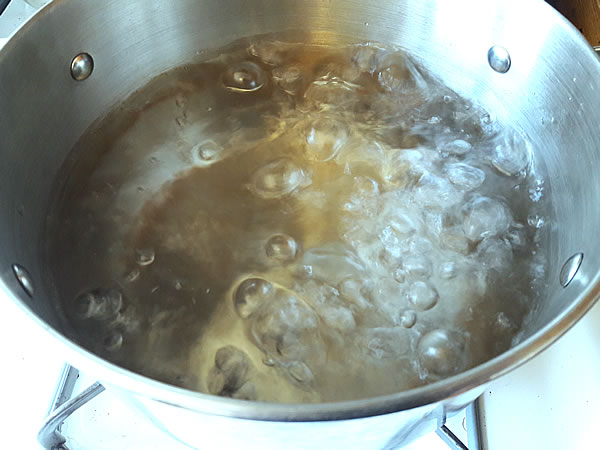










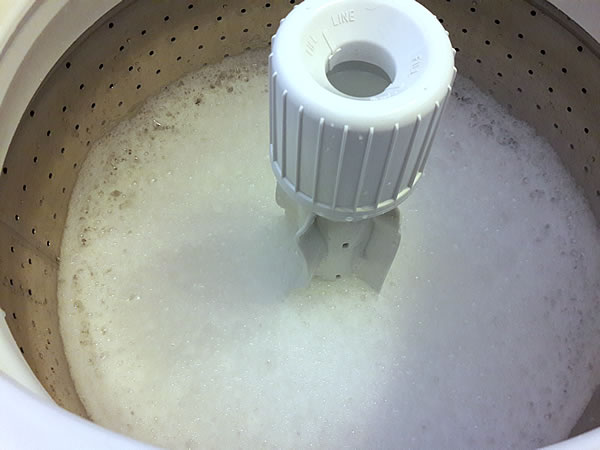
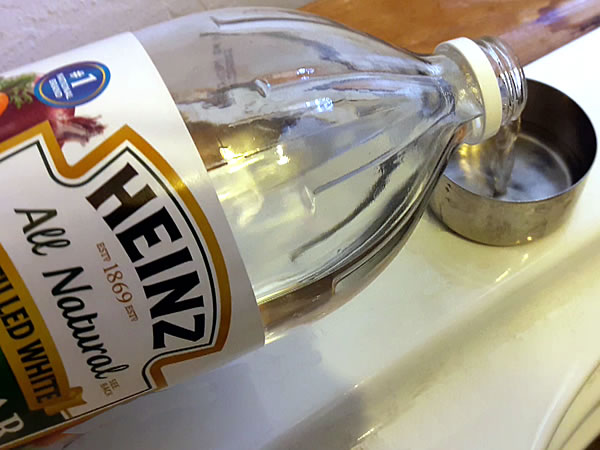


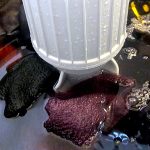

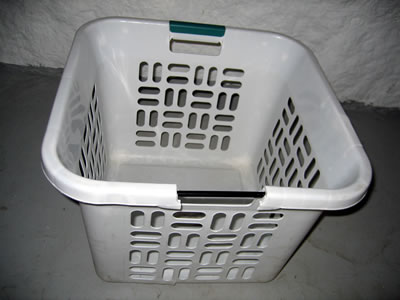
Have access to a veryl arge amount of soap berries glad I found this article. I will be making laundry soap now. I have been trying to find a wholesale buyer with no kuck
I got some soap berries from the Bulk barn store- i’m in Canada. they are pretty reasonable there. ($ 3.33 per 100 grams….so whatever that works out to for a pound- 450 grams) thats more than enough to make about 4 litres of the soap- which is cheap! i’ve been buying Tide liquid laundry soap for years and been paying an arm and a leg! lol
In trying to change out lifestyle to incorporate eco friendly and chemical free…i came across soap berries and im glad i found it! i’m making some soap right now for the first time and im super thrilled!!
Interesting you bought a top loading machine. From my research, front loaders are more energy and water efficient.
I bought the washer in early 2016, but it’s my recollection that in doing my research, I found that despite positive ratings from professional reviewers, there were many negative consumer reviews of front loaders from people who actually used the washers on a regular basis stating that clothes didn’t get clean and had to be re-washed. My thought was that wouldn’t save money or electricity if clothes had to be washed twice. Also, I read that you need to leave the door open on front loaders so they don’t grow mold. Our washer is in a very narrow back hall without enough room to leave the door open. The Speed Queen is a workhorse with an amazing warranty that gets clothes clean super fast and got just AMAZING user reviews. It’s possible that front-loaders have improved since I did my research, but this was the best choice for us at the time.
This is my absolute favorite laundry detergent recipe. The boiling water and soaking the soap nuts overnight really activates them and allows me to wash with cold water.
Thanks for sharing!
I buy the Dropps off Amazon. I’ve become a huge laundry pod fan since there’s no mess or fuss. The bleach pods from Clorox are really convenient. If it takes a cup of “soap nutz detergent” to clean one load of clothes, that’s a lot you have to cook up at one time.
My daughter muxes 1 cup of soap nut liquid in a gallon jug with 1 cup baking soda and fill with water. She used 1/2 cup of this liquid for each load of laundry. Her laundry is very clean and deorderized.
Please read this article on why home made laundry soaps are not effective cleansers. After years of washing my clothes in cold water and mild soap my clothes stank. Once I started using proper hot water and strong detergent the laundry water came out as black as you see in that article’s photos. But now my clothes are finally clean.
http://www.fortheloveofclean.com/laundry-love/homemade-detergent/testimonials-from-former-users-of-homemade-soap-photo-gallery/
What are you using now?
Still possible to get powder laundry in cardboard box.
I’m using Lidl’s Formil Aktiv, because it was recommended by a consumers’ rights magazine for best quality/price value. But when it’s over I’m going back to my favorite, Ultra Pro Active – they’re both in powder form, sold in cardboard boxes. No plastic is important to me.
http://himik.lviv.ua/index.php?route=product/manufacturer/info&manufacturer_id=8
https://www.pingodoce.pt/produtos/detergente-em-po-active-40-doses/
My daughter dilutes the soap nut liquid in a milk jug. 1 cup soap liquid, 1 cup baking soda and fill with wTer. Use 1.2 cup of this liquid for each load. Her laundry smells fresh… even husbands work clothes
Soapnuts have been used to wash laundry or to make body wash in India for generations. However, soapnuts have become more and more popular in Europe and the USA. The growing demand has led to the extensive export of soapnuts, which in turn has led to soapnuts becoming too expensive for many natives to afford. Instead, they use chemical detergents that contribute to the water pollution, which is already an issue of concern in India. To top it off, those nuts need to be shipped across the globe, leaving quite the carbon footprint.
Unless you live in India and see this first hand, you’re full of it.
I love how the booj capitalists don’t want to believe their enormously wasteful enviro habits have a negative impact in the exploited core.
What eline said is absolutely true. I am an Indian, and soap nuts have become extremely expensive for us. We have been using soapnuts traditionally for a lot of uses (Most commonly to wash hair), and the poorer people of India are no longer able to afford it.
I’ve found something interesting, at least for where I live. You can also use horse chestnuts that also contain saponin but you can find in Autumn almost everywhere in places where the trees are present.
http://wastelandrebel.com/en/faq-conkers-horse-chestnuts-as-an-all-natural-laundry-detergent/
It’s free and it’s local! I can’t wait to try it.
Please report back your results!
Yes, I will, it’s soon the time for them to fall here. I just re-read my comment, please forgive my bad English!
Great idea! I am trying this today- thank you
The washing machines in my apartment building don’t have a compartment for fabric softener so I’ve just been skiping it and using only natural store-bought detergent. But if I use soap nuts will it work better if I use vinegar in the rinse cycle?
Yes, I do think it will work better. It would be challenging to make sure you are there to add the vinegar at the right time, but it would make the soapnuts work better.
Oh, I make dry laundry detergent with washing soda, 20 mule team borax and Zote laundry soap. Grate the soap, then blend with 3 cups each of soda and borax. (I run through a food chopper.) White vinegar for softener. I’ve been doing this for several years. Curiously, haven’t had eczema since.
I bought a Speed Queen a couple of years ago. Love it! The appliance tech who had kept my Kenmore going far past a normal life strongly suggested the Speed Queen. I went to the local appliance store and said I want to buy my last washer; he said, then buy a Speed Queen (I’m 60+). I know why I bought mine; I’m curious as to why you did so.
Please tell us why you went with a top loader. We’ve been thinking of switching to a front loader to use less water…
For us, a front loader would not work. After a lot of research, it became clear that front loaders are often susceptible to mold unless you leave the door open at all times. Our laundry area is in a very narrow hallway that we have to walk through on a regular basis. There would not be room to leave a washing machine door open all the time. Other people may not have this issue.
oh good to know… I live in a super dry climate with a huge laundry room so I guess I’ll go with a front loader then, since it uses less water. Thanks for responding
One suggestion I have is to go with a machine with the least electronic parts. While those machines may use less water, I have read many negative reviews about the parts breaking after a very short period of time or the machines not actually cleaning the clothes well enough and loads having to be redone. I don’t know what your budget is, but Speed Queen gets superior marks from actual users for its sturdiness over time. They really hold up well. And they have a front load model: https://www.speedqueen.com/products/front-load-washers.aspx (Note: I do not benefit in any way from recommending this brand. I just really love that they are so durable.)
I have a front loader and our laundry area sounds like yours – in a narrow hallway, etc, etc. My stacking washer/dryer are in a closet. I bought them to save room for storage in the rest of the closet. The bi-fold doors on the closet do not allow me to leave the washer door wide open but I can leave it ajar enough to have air circulate. I’ve never had a problem with any mold or odor and I’ve had this washer for about 6 years. This is my 4th front loader and I’d never go back to a top loader. Also, my son and family had a top loader without an agitator and it was the noisiest thing I ever heard – I’d avoid those.
If you aren’t up to making a batch of liquid, you can just make a tea with the wash bag for cold water loads. I microwave some water in an old mug and let the wash bag steep for a few minutes. I toss the liquid and the bag into the washer and add the clothes. I’ve found that I can get 5 loads out of a wash bag containing 5 soap nuts if I make tea each time.
Is there any reason you use Chinese soapberry instead of the Western soapberry that is native to the US? I’ve heard mixed reports about people washing with soapberry and now I wonder if it is because they used them in cold water. Thank you for the informative post.
Soapnuts need to be soaked in a container of hot water for at least five minutes to activate them and then dumped into the cold water of the machine.
I would love to hear about your decision to get a top loader. I hate my High Efficiency front loading washer which stinks and warns you against vinegar because the plastic seal will crack.
I’ve been using vinegar as a rinse agent for 5 years and my front loader is just fine. I only use 1/2 C. vinegar (it’s hot a huge machine) and mixed with the rinse water it just doesn’t seem to affect the seals one bit.
I’ve previously wondered why you have a top loader. I’d definitely be curious to hear why you’ve opted for another
The previous one was free. It was given to us by our previous landlady when we moved. We didn’t really “choose” it. But I’ll be happy to explain why we went with another top loader instead of a front loader this time.
Yes! Please tell us about your washer decision.
I’m interested in knowing what factors you condisered in buying your new washing machine. We will need to replace ours soon.
I use washing soda mixed in hot water for all my laundry washing. A concentrated mix for oily fabrics like pillow slips, a milder one for the rest.i don’t need fabric softener, & for stains I use a Sard bar or felsNaptha. Lectric soda in Australia has good recipes for all cleaning needs, using washing soda, baking soda, vinegar etc. save the planet one wash at a time, and save a lot of money
I can’t believe it’s been 8 years! We unfortunately use plastic jugs but I bought some soap nuts to try and I didn’t even know they don’t work in cold water! Thanks for the heads up!
(also I really want the story behind your new washing machine)
Just made this yesterday! Decided to use it as an all purpose household and laundry cleaner: dish soap, counters, stove, floor, laundry, etc. So far so good. Though I made 1 cup with 5 nuts as I purchased just a small sample for $4. Definitely will try the large 1lb bag as it would be a much better value. The consistency is thin, but it’s bubbling up!